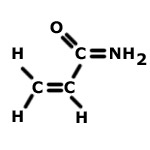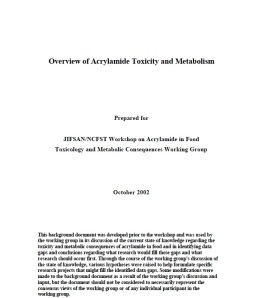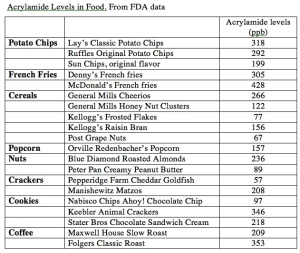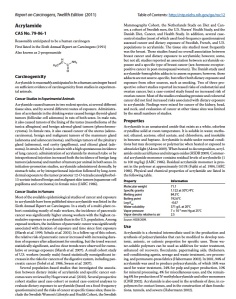News reports are full of lists of food additives to be avoided, ranging from artificial sweeteners to MSG, BHA and BHT, trans fats to sodium nitrate, sodium sulfite, and sulfur dioxide… as well as food dyes and high fructose corn syrup. Controversies rage over the long-term health consequences of ingesting these common food additives. However, there is great concern over another chemical, acrylamide, which is NOT an additive, but a by-product of cooking.
Acrylamide is a chemical that forms in plant-based, high carbohydrate foods when they are cooked – by frying, deep frying, grilling, roasting or baking – at high temperatures. Roasting any bean, seed, nut or grain produces acrylamide. It is generated during the browning process. In contrast, boiling, steaming and microwaving do not appear to lead to the formation of significant levels of acrylamide. It is found in processed foods, as well as home-cooked and restaurant-prepared foods.
 More specifically, Acrylamide is an organic molecule (C3H5NO), also known as 2-propenamide, that forms in starchy foods that contain natural sugar as well as asparagine, an amino acid. Acrylamide forms at temperatures over 100° C (373° F) during the browning of the Maillard Reaction, a chemical reaction first described in 1912 by French chemist Louis-Camille Maillard. This involves a reaction between an amino acid and a reducing sugar (such as glucose or fructose) that requires heat. This browning step is crucial to imparting flavor, color and texture to food. Consider the difference in taste and feel between eating a doughy pizza crust and a crispy golden brown one.
More specifically, Acrylamide is an organic molecule (C3H5NO), also known as 2-propenamide, that forms in starchy foods that contain natural sugar as well as asparagine, an amino acid. Acrylamide forms at temperatures over 100° C (373° F) during the browning of the Maillard Reaction, a chemical reaction first described in 1912 by French chemist Louis-Camille Maillard. This involves a reaction between an amino acid and a reducing sugar (such as glucose or fructose) that requires heat. This browning step is crucial to imparting flavor, color and texture to food. Consider the difference in taste and feel between eating a doughy pizza crust and a crispy golden brown one.
Where has acrylamide been detected? It is found in cookies, crackers, potato chips, French fries, breakfast cereal, popcorn, nuts, peanut butter, biscuits, bagels, pizza crust and bread. Acrylamide is also found in coffee and beer, as well as cocoa powder and chocolate products. Acrylamide is also found in certain canned products, such as black olives, sweet potatoes and pumpkin, as well as dried fruits.
What is the danger?
 A 2002 study by researchers of the Swedish National Authority first identified levels of acrylamide in foods. However, note that acrylamide has been a part of our diet since humans first began cooking food by fire. Subsequent research found that high levels of acrylamide are associated with increased risk of cancer and reproductive problems in laboratory animals, including rats, mice, monkeys, dogs and cats. Specific results of exposure to rodents included tumors of the testes and thyroid, cancer of the uterus, as well as lung cancer. Note that these were levels far higher than found in the human diet.
A 2002 study by researchers of the Swedish National Authority first identified levels of acrylamide in foods. However, note that acrylamide has been a part of our diet since humans first began cooking food by fire. Subsequent research found that high levels of acrylamide are associated with increased risk of cancer and reproductive problems in laboratory animals, including rats, mice, monkeys, dogs and cats. Specific results of exposure to rodents included tumors of the testes and thyroid, cancer of the uterus, as well as lung cancer. Note that these were levels far higher than found in the human diet.
Acrylamide is labeled a genotoxic carcinogen, as it may cause cancer by interacting with an organism’s genetic material. The National Institutes of Health (NIH) states that, “Acrylamide is reasonably anticipated to be a human carcinogen based on sufficient evidence of carcinogenicity from studies in experimental animals.” It may also cause damage to the reproductive and nervous systems in humans, including impaired muscle function, and could potentially play a role in pancreatic cancer, as well as neurodegenerative diseases, such as Alzeheimers .
How much acrylamide is safe?
Typical levels of acrylamide in foods (in ppb) in individual servings of potato chips typically range from 200 to 400 parts per billion (ppb). See a complete listing on FDA website. Levels of acrylamide in breakfast cereals range from 25 to 500 ppb. Levels can be quite high in roasted nuts; a single serving of roasted almonds can be as high as 450 ppb. A few representative samples are shown in the table; data are from the FDA website.
International organizations such as the UK’s Food Standards Agency (FSA) and the World Health Organization (WHO) stipulate that exposure to acrylamide should be “as low as reasonably practicable” or ALARP. The International Agency for the Research of Cancer (IARC) has classified Acrylamide as “2a,” declaring it a potential carcinogen to humans. Acrylamide is included on California’s Proposition 65 ‘right to know’ list of chemicals regarded to cause cancer or reproductive problems.
The U.S. Food and Drug Administration has not declared acrylamide a health risk to humans, and they do not recommend dietary changes to avoid acrylamide. However, studies are ongoing to assess the risks to humans of dietary acrylamide. Additional data and risk factors for acrylamide can be found on the EPA website.
How can I avoid acrylamide?
Acrylamid levels are no different for organic vs. non-organic food. The best way to limit your exposure to acrylamides is to eat a healthy diet, incorporating a variety of fruits, vegetables, whole grains, dairy, lean meats, and to limit your intake of processed foods. A typical American household has been estimated to spend nearly 90% of their food budget on processed foods.
 When cooking at home, manufacturer’s instructions for frying or baking should be followed. Higher levels of acrylamide form when foods are cooked at a higher temperature, or for longer cooking times. The main recommendation is to avoid over-cooking food. Bread should be toasted to a pale brown, not a dark brown color. Significantly, frying has been found to lead to the highest levels of acrylamide. French fries or roasted potatoes should be cooked to a golden yellow, rather than a crispy brown color.
When cooking at home, manufacturer’s instructions for frying or baking should be followed. Higher levels of acrylamide form when foods are cooked at a higher temperature, or for longer cooking times. The main recommendation is to avoid over-cooking food. Bread should be toasted to a pale brown, not a dark brown color. Significantly, frying has been found to lead to the highest levels of acrylamide. French fries or roasted potatoes should be cooked to a golden yellow, rather than a crispy brown color.
Additional tips from the U.S. National Toxicology Program recommend frying foods at temperatures lower than 338 degrees Fahrenheit. Do not store raw potatoes in the refrigerator, and soak raw potato slices in water for 15 to 30 minutes, then dry before roasting or frying.
 Raw nuts, rather than roasted nuts will have lower levels of acrylamide.
Raw nuts, rather than roasted nuts will have lower levels of acrylamide.
Levels of acrylamide in baby foods are generally negligible, with the exception of teething biscuits and processed sweet potatoes.
Acrylamide forms in coffee when the coffee beans are roasted, not during the brewing process, so the length of brewing has no effect on acrylamide levels.
The process of roasting cocoa beans produces acrylamide. There’s more acrylamide in dark chocolate than milk chocolate.
Tobacco appears to be a major contributor to acrylamide exposure. Preliminary studies indicated that acrylamide biomarker concentrations are four to five times higher in smokers vs. nonsmokers. The easiest way to avoid acrylamide is to avoid smoking as well as exposure to second-hand smoke.
What about other sources?
A related compound, polyacrylamide, is used in the purification of drinking water, where it acts as a coagulant, combining with solid materials to make them easier to remove by filtration. During this process acrylamide is released. The EPA’s Safe Drinking Water Act regulates contaminants in drinking water as Maximum Contaminant Level Goals (MCLG); this limits the quantity of polyacrylamide that can be added to raw (unpurified) water. See: Basic Information about Acrylamide in Drinking Water.
Acrylamide is also found in cigarette smoke. The chemical is also used in grouts and cements, as well as the industrial processing of paper, fabrics and dyes. Acrylamide and polyacrylamide are also found in certain cosmetics.
What changes is industry implementing?
In 2005, California filed suit against manufacturers of potato chips and french fires, to require them to notify consumers about acrylamide. Companies singled out included McDonald’s Burger King, Wendy’s, KFC, Kettle Foods, Frito-Lay, Proctor and Gamble, and H.J. Heinz. These companies avoided trial by agreeing to pay fines, change their labeling procedures, and reduce levels of acrylamide in their foods over a time period of three years.
There is no simple solution to eliminate acrylamide in all foods, but the food industry is developing procedures to reduce the formation of acrylamide in processed foods. A switch to the enzyme, asparaginase has been shown to reduce acrylamide levels. Another pathway has explored agricultural innovations, such as increasing soil sulfur levels, or reducing nitrogen levels in crops.
Few systematic studies have yet been completed on the long-term effects on humans. Further research is needed to illuminate the potential hazards of exposure to acrylamide. The European Food Safety Authority (EFSA) has begun a full assessment, evaluating levels of acrylamide in foods, and the associated toxicity to humans. They anticipate releasing a draft of their scientific opinion in 2014, and final recommendations in 2015.









